Azure News Digest: All Build 2014 Announcements
As part of this digest of news from the Microsoft Azure cloud platform , the main announcements for developers, IT professionals and for all professionals interested in cloud technologies and the Azure platform are collected.
The largest Microsoft Build 2014 conference was held last week , during which many announcements were made, including on the technologies of the Microsoft Azure platform.
This digest contains all the announced announcements:

You should start this digest with a small but significant news: the Microsoft Windows Azure platform is now called Microsoft Azure or simply Azure. This is a landmark renaming, which reflects the openness of the platform to any technologies, development languages, frameworks and tools, operating systems based on Linux and Windows Server.
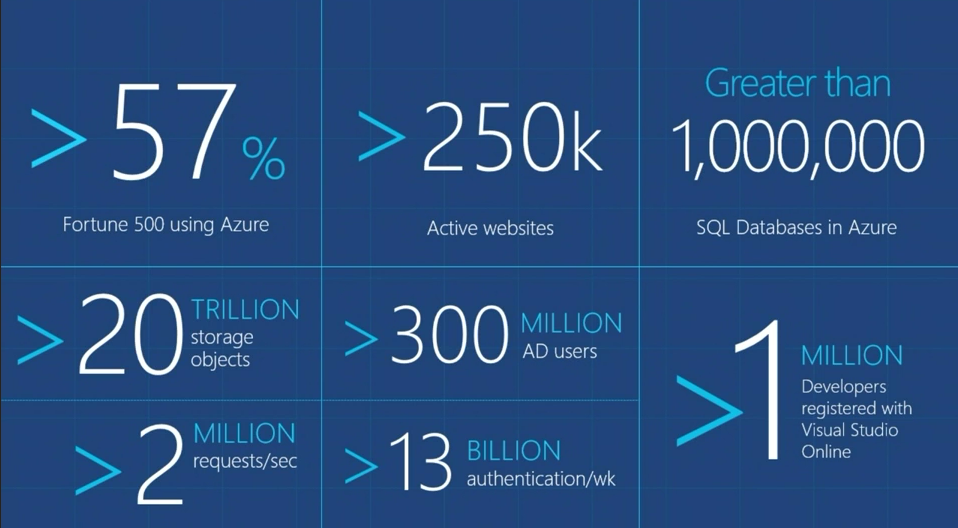
The conference announced the results of the development of the Microsoft Azure cloud platform over the course of the year. Among them:
In addition to these results, some interesting examples of the modern use of Microsoft Azure were given, for example, for organizing an online broadcast of the Olympic Games on the NBC Sports channel in the United States for hundreds of millions of viewers with a record peak of 2.1 million simultaneous connections to the HD broadcast of the USA – Canada hockey match .
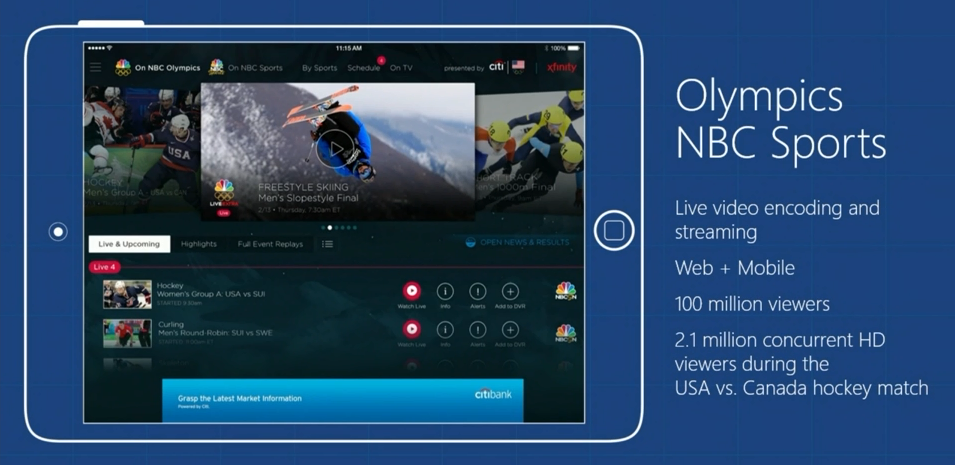

Another example is Titanfall, a popular game for Windows and Xbox, whose multi-user mode, artificial intelligence and network functions are fully implemented on the basis of the Azure cloud. According to Microsoft, at the start of the game, a pool of 100,000 virtual machines was used, which ensured a smooth start of the game and trouble-free processing of peak interest from players.
Azure Web Sites, a PaaS web application hosting service, has received a number of remarkable innovations, including useful ones for Java developers.
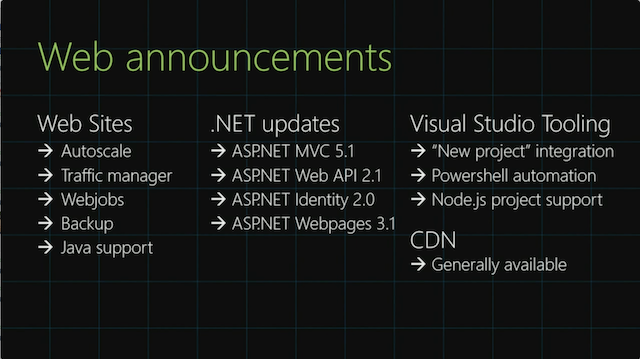
Java support . The Web Sites platform previously offered support for hosting code based on .NET, PHP, Python, and Node.JS. During the conference, support for posting Java code was announced . When deployed, developers can select the Tomcat or Jetty application server in the control panel. In addition, the placement of 64-bit applications that can consume a large amount of memory is supported. Details about new features and usage examples can be found here . Free SSL offer
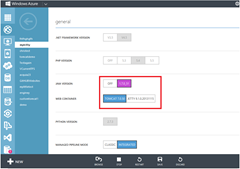
. Now users of the standard edition of Web Sites get a free opportunity to enable SSL-mode support for their web applications. Users can count on one free IP address and 5 SNI.
Hosting plans and resource groups . The pricing of Web Sites has been slightly changed , a new level of provision of the Basic service has been added, which offers dedicated computing power, but costs up to 50% cheaper than the standard level due to the inaccessibility of a number of functionality, for example, automatic scaling. Learn more about the new pricing of Azure Web Sites on the official page . More information about hosting plans can be found in this announcement .
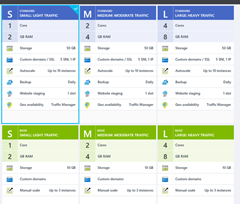

The standard website hosting plan was updated: in addition to the free SSL offer, the amount of storage space allocated for the website was increased from 10 GB to 50 GB.
In addition to new hosting plans, a new approach was introduced to combine several websites with different pricing - Resource Groups. This feature will help manage resources and allocate them differently for different tasks. You can learn more about the new feature from this article .
Kudu update . For each website launched in Azure Web Sites, there is a Kudu control panel that allows you to easily manage a number of site parameters, receive diagnostic information and logs.

Kudu update introduced a new ability to view and manage the list of processes, load process memory dumps, and process shutdowns.
Azure Mobile Services offers the possibility of organizing a single backend for a wide variety of mobile platforms: iOS, Android, Windows, Windows Phone, HTML5 / JS, PhoneGap, Xamarin and others. As part of Build 2014, a number of new features were announced for the cloud platform.
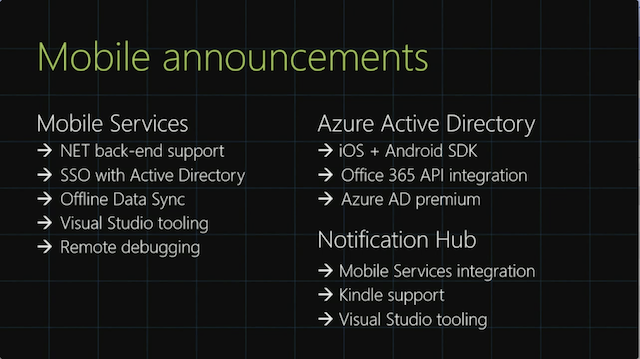
.NET as a backend . One of the most interesting announcements regarding mobile services was the announcement of the ability to develop a backend code for mobile applications in Azure Mobile Services in any supported .NET language.
Local and remote debugging . Together with the previous announcement, the possibility of local and remote debugging of the backend code of mobile applications is presented.
Offline data synchronization . The Azure Mobile Services backendAdded built-in support for offline data synchronization. Now, with the help of built-in tools, developers can build applications with script support, when applications can work without an Internet connection, followed by synchronization with the backend.
Kindle support . Announced support for sending push notifications to Kindle devices. Examples and detailed information are available at the following link .
The SQL Server cloud-based relational database available as a service has received a significant portion of updates.
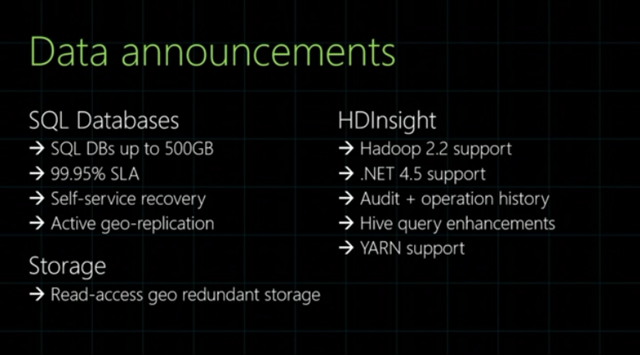
New limits and SLA . The limit on the size of one SQL Database has been increased from 150 GB to 500 GB. Along with this innovation, the SQL Database Premium SLA service has now been increased to 99.95%.
Automatic backups (Self-Service Restore) . The SQL Database service received support for automatic backups with the ability to accumulate up to 31 versions of the database and roll back to any of the previous saved versions.

Active Geo-Replication . The new feature of active geo-replication will allow SQL Database Premium users to automatically receive up to four active database replicas distributed around the world.
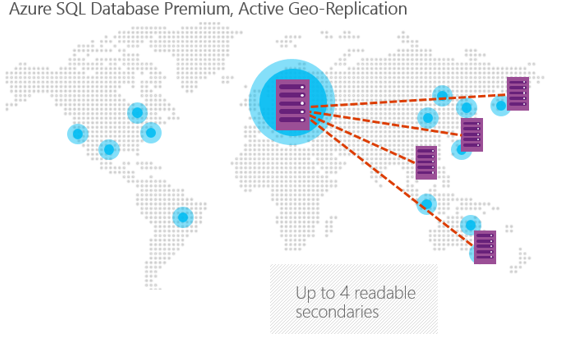
These replicas can be used for emergency switching in case of failure of one of the data centers in the results of any disaster.
One of the most pleasant and unexpected announcements of the Build cloud conference was the announcement of a new version of the portal for managing cloud capabilities, billing, features of web applications and services, code and other functions. The portal is a completely new rethinking of working with Microsoft Azure cloud capabilities and offers a huge number of innovations, including:
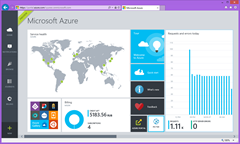
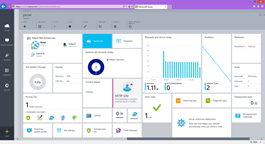
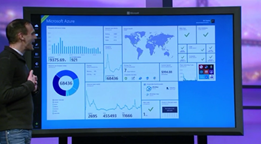
You can familiarize yourself with the main features of the new portal in this short video (3 minutes). Currently, the new portal only supports work with the Azure Web Sites, Visual Studio Online, SQL Databse, and MySQL services. Support for all other parts of the Azure platform will be gradually added.

As the main announcement of infrastructure administration in the Azure cloud, there was an announcement about the deep integration of two third-party tools - Puppet and Chef into workflows when creating virtual machines.
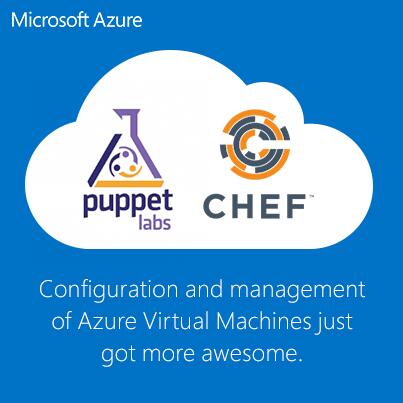

Support for Puppet and Chef . In collaboration with Puppet Labs and Chef, a new virtual machine management mechanism was introduced that was tightly integrated into the Azure control panel. To host the infrastructure with integration with Puppet in the virtual machine gallery, an image with Linux-based Puppet Enterprise was added, after the deployment of which the integration of virtual machines at the stage of their creation is allowed. To do this, an agent is added to the virtual machine (Windows Server or Linux), which provides communication with the deployed Puppet. A plugin has also been released for developers.
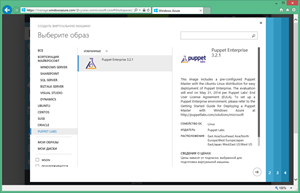
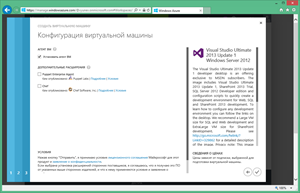
Puppet Plugin for Visual Studio 2013, which makes it easy to create and manage Puppet modules. In addition, a downloadable Getting Started Guide for Deploying Puppet Enterprise in Microsoft Azure is available for developers and IT professionals .
VM Capturing . The long-awaited function allows you to take and subsequently deploy a snapshot of a virtual machine with data disks connected to it. This feature is currently available through PowerShell commands.
New Azure Automation Service . An important announcement of the Build conference was the release of a preliminary version of the Azure Automation service- New functionality that is designed to automate the creation, deployment, monitoring and maintenance of resources in the Azure cloud using a highly scalable and reliable mechanism for executing workflows.
Developers can use the new service to automate the execution of frequently used steps, for example, the deployment of off-the-shelf resource sets. The announcement of the new service can be found here . Description of the service can be found on the official website . Walkthrough is available in this article .
PowerShell for Azure Resource Manager (ARM). Instrumental support for Azure Automation is provided by the new PowerShell-based framework that allows you to host and automatically scale cloud applications and resources. ARM is part of the Azure SDK 2.3, which is described below. Read more about using the new features for deploying Dev & Test environments in this article .
Auto scaling . The automatic scaling mechanism has been put into commercial operation. This service allows you to automatically scale computing resources, including virtual machines, cloud services, websites and mobile services, new
virtual networks. The Point-To-Site VPN virtual network connection feature has been released for commercial use (GA).
Other innovations include support for Dynamic Routing Gateway functions, migration of VMs to other subnets, and the ability to configure static IP addresses for virtual machines. All of these features are primarily available through PowerShell commands.
Among other things, the Azure SDK for .NET cloud application development tools were updated with integration in Visual Studio and new useful features.
Azure SDK for .NET 2.3 . During the Build conference, an update to the Azure SDK cloud application development tools was introduced with integration into Visual Studio 2013 Update 2 RC. Installing a package or updating it is available from the Web Platform Installer . Below you will find a description of some of the most notable innovations.
Web Application Creation Wizard . Several new features have been added to the Web Application Project Wizard. Firstly, a new web application template is introduced - Azure Mobile Service, which is designed to develop a mobile service backend API.
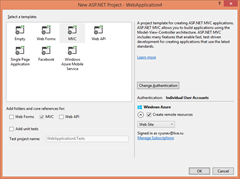
Secondly, the wizard adds the ability to automatically create new resources for hosting a web application: an instance of the Web Sites service or a virtual machine. For both options, there is a remote debugging feature of a web application hosted in the cloud.
Web site management . Now from Server Explorer you can manage not only the sites themselves, but also the application files deployed in them, as well as the application log files.
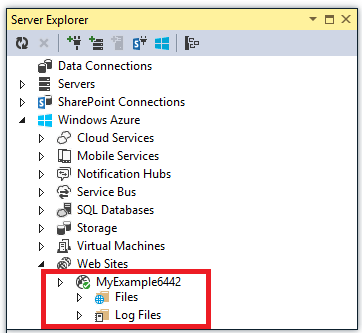
Cloud services . To test cloud services, a new Emulator Express was introduced , which allows you to debug services without administrative privileges. In addition, remote debugging of managed and native application code is available for cloud services .
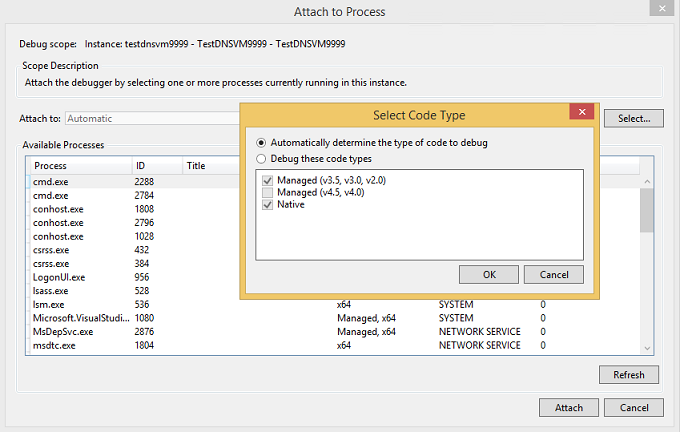
Testing push notifications . The updated Visual Studio 2013 Update 2 RC tools introduced a new tool for testing the sending of push notifications through the Azure Notification Hubs service.
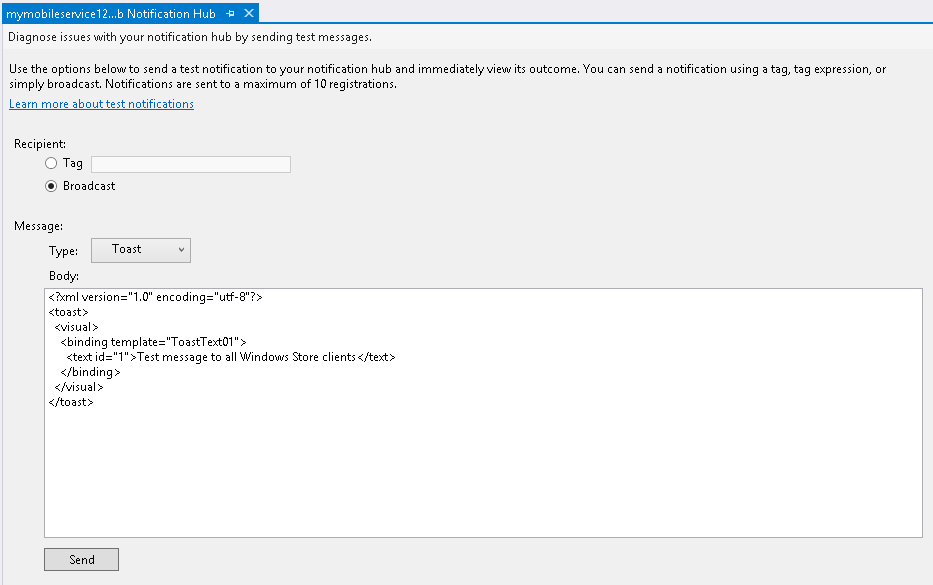
You can read more about its application in this article .
Manage virtual machines . Now, using Server Explorer, you can create and delete virtual machines directly from Visual Studio. Machines from the Azure Virtual Machine Gallery are available to choose from.
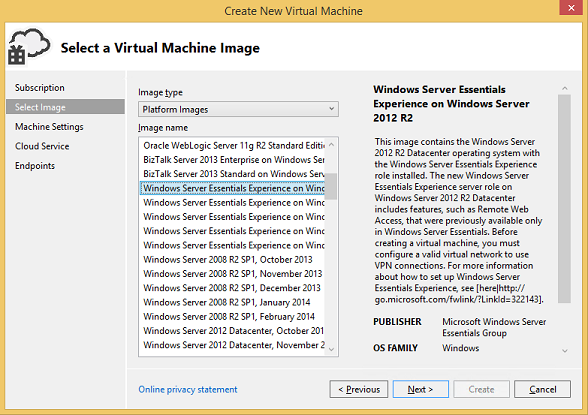

In addition, using the new Azure SDK 2.3 features from Visual Studio, you can enable remote debugging mode for applications deployed in virtual machines.
Azure CDN Content Distribution Network has received a second life and significant infrastructure upgrade. The new version of CDN was put into commercial operation, and also became available for management through the Azure portal.
Azure CDN host location information can be found in this article .
The cloud-based authentication system has received a number of important innovations and features.
Azure Active Directory Premium GA . Azure Active Premium has reached commercial use status.
Azure Active Directory RMS . Along with the commercialization of Active Directory Premium, the Azure portal integrated the Azure Rights Management function to manage access rights to specific content in Azure and Office 365. Details in this article .
iOS and Android SDK . Released SDK toolkits for working with Active Directory from mobile applications based on iOS and Android.
An important announcement that a few days before Build 2014 was a dramatic reduction in the price of computing power and storage resources in the cloud. Along with the price reduction, a new level of virtual machines was introduced - Basic, which offers A0-A4 virtual machines at a reduced price by eliminating a number of functions that may not be used by developers, for example, automatic scaling.
As part of its promise to maintain price parity with competitors, the prices of core resources were set in accordance with Amazon prices or even lower: More information about changes in prices for computing power and storage resources, compared with Amazon, can be found in this announcement . Azure Backup pricing
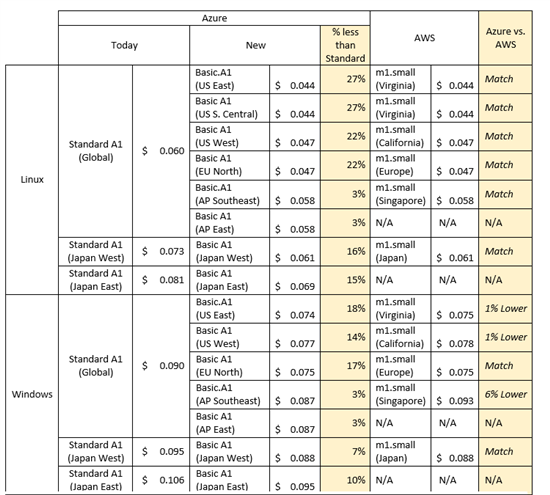
. In addition to changing prices for computing power and storage, prices for the Azure Backup backup storage service were also adjusted . New prices. which can be found on this page have been reduced from 17.33 RUB to 9.71 RUB per gigabyte over the first five gigabytes.
Availability of SQL Server 2014 in the Azure Virtual Machine Image Gallery.
Released tools Node.js Tools for Visual Studio 1.0 Beta with support for free Visual Studio 2013 for the Web Express !
Visual Studio Online service launched in commercial operation (General Availability).
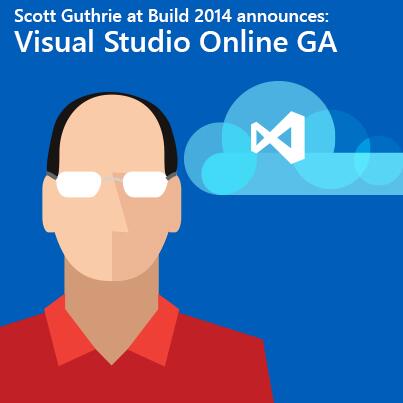
Access to the preliminary version of Application Insights has been opened to all interested developers.
Launch of the .NET Foundation http://www.dotnetfoundation.org/
Roslyn compiler source code is published under the free Apache 2.0 license https://roslyn.codeplex.com/
Announcement of Smooth Streaming Plugin for OSMF with WAMS MPEG-DASH (Beta) support.

- Microsoft Azure development results for the year . 300 new services. Current load and a couple of notable projects;
- Web Sites . Java support. Free SSL certificates. Hosting plans and resource groups. Kudu update
- Services Mobile . .NET languages as a backend. Remote debugging. Offline data synchronization. Kindle support.
- The Database the SQL . New limits and SLA. Automatic backups (Self-Service Restore). Active Geo-Replication.
- Portal Azure . New management portal with Application Insights integration, billing and other new products.
- Virual Machines & Networks . VM Capturing. Platform integration with Puppet and Chef. New Azure Automation Service. Auto-scale GA. Novelties of virtual networks.
- Azure CDN. Update and GA. Portal integration.
- Azure Active Directory Active Directory Premium GA. Active Directory RMS features in the portal. iOS & Android SDK.
- Development tools . Azure SDK for .NET 2.3, integration with Visual Studio
- New prices . Lower prices for computing power (up to 35%) and cloud storage (up to 65%). VM Basic Level Lower Azure Backup pricing.
You should start this digest with a small but significant news: the Microsoft Windows Azure platform is now called Microsoft Azure or simply Azure. This is a landmark renaming, which reflects the openness of the platform to any technologies, development languages, frameworks and tools, operating systems based on Linux and Windows Server.
Microsoft Azure Platform Development Results for the Year

The conference announced the results of the development of the Microsoft Azure cloud platform over the course of the year. Among them:
- Microsoft has released over 300 new features on the platform;
- The conference announced the launch of another 44 new features. Details below;
- Recently, new platform data centers have been launched in China and Japan. Microsoft is the only global cloud provider to offer cloud platform services in China;
- Microsoft Azure today has 16 public regions to host data and code around the world;
- Over 57% of the largest Fortune 500 companies already use the Azure platform;
- Microsoft Azure has more than 250,000 websites (Azure Web Sites) and more than a million databases (Azure SQL Database). In the Azure Storege distributed storage, users have already saved more than 20 trillion objects;
- Over a million developers have signed up for Visual Studio Online, an Azure-based development platform that integrates with desktop development tools.
In addition to these results, some interesting examples of the modern use of Microsoft Azure were given, for example, for organizing an online broadcast of the Olympic Games on the NBC Sports channel in the United States for hundreds of millions of viewers with a record peak of 2.1 million simultaneous connections to the HD broadcast of the USA – Canada hockey match .


Another example is Titanfall, a popular game for Windows and Xbox, whose multi-user mode, artificial intelligence and network functions are fully implemented on the basis of the Azure cloud. According to Microsoft, at the start of the game, a pool of 100,000 virtual machines was used, which ensured a smooth start of the game and trouble-free processing of peak interest from players.
Azure web sites
Azure Web Sites, a PaaS web application hosting service, has received a number of remarkable innovations, including useful ones for Java developers.

Java support . The Web Sites platform previously offered support for hosting code based on .NET, PHP, Python, and Node.JS. During the conference, support for posting Java code was announced . When deployed, developers can select the Tomcat or Jetty application server in the control panel. In addition, the placement of 64-bit applications that can consume a large amount of memory is supported. Details about new features and usage examples can be found here . Free SSL offer

. Now users of the standard edition of Web Sites get a free opportunity to enable SSL-mode support for their web applications. Users can count on one free IP address and 5 SNI.
Hosting plans and resource groups . The pricing of Web Sites has been slightly changed , a new level of provision of the Basic service has been added, which offers dedicated computing power, but costs up to 50% cheaper than the standard level due to the inaccessibility of a number of functionality, for example, automatic scaling. Learn more about the new pricing of Azure Web Sites on the official page . More information about hosting plans can be found in this announcement .


The standard website hosting plan was updated: in addition to the free SSL offer, the amount of storage space allocated for the website was increased from 10 GB to 50 GB.
In addition to new hosting plans, a new approach was introduced to combine several websites with different pricing - Resource Groups. This feature will help manage resources and allocate them differently for different tasks. You can learn more about the new feature from this article .
Kudu update . For each website launched in Azure Web Sites, there is a Kudu control panel that allows you to easily manage a number of site parameters, receive diagnostic information and logs.

Kudu update introduced a new ability to view and manage the list of processes, load process memory dumps, and process shutdowns.
Azure Mobile Services
Azure Mobile Services offers the possibility of organizing a single backend for a wide variety of mobile platforms: iOS, Android, Windows, Windows Phone, HTML5 / JS, PhoneGap, Xamarin and others. As part of Build 2014, a number of new features were announced for the cloud platform.

.NET as a backend . One of the most interesting announcements regarding mobile services was the announcement of the ability to develop a backend code for mobile applications in Azure Mobile Services in any supported .NET language.
Local and remote debugging . Together with the previous announcement, the possibility of local and remote debugging of the backend code of mobile applications is presented.
Offline data synchronization . The Azure Mobile Services backendAdded built-in support for offline data synchronization. Now, with the help of built-in tools, developers can build applications with script support, when applications can work without an Internet connection, followed by synchronization with the backend.
Kindle support . Announced support for sending push notifications to Kindle devices. Examples and detailed information are available at the following link .
Azure SQL Database
The SQL Server cloud-based relational database available as a service has received a significant portion of updates.

New limits and SLA . The limit on the size of one SQL Database has been increased from 150 GB to 500 GB. Along with this innovation, the SQL Database Premium SLA service has now been increased to 99.95%.
Automatic backups (Self-Service Restore) . The SQL Database service received support for automatic backups with the ability to accumulate up to 31 versions of the database and roll back to any of the previous saved versions.

Active Geo-Replication . The new feature of active geo-replication will allow SQL Database Premium users to automatically receive up to four active database replicas distributed around the world.

These replicas can be used for emergency switching in case of failure of one of the data centers in the results of any disaster.
New Azure Portal
One of the most pleasant and unexpected announcements of the Build cloud conference was the announcement of a new version of the portal for managing cloud capabilities, billing, features of web applications and services, code and other functions. The portal is a completely new rethinking of working with Microsoft Azure cloud capabilities and offers a huge number of innovations, including:



- scalable, customizable modern UI with support for touch screens, the concept of blades and a huge number of options for configuring the presentation of information;
- convenient and detailed work with billing, plans and expenses;
- integration with Application Insights analytics service, viewing service data;
- integration with Visual Studio Online, online code editor, command console;
- integration and display of the state of cloud capacities around the world, integration with the notification system.
You can familiarize yourself with the main features of the new portal in this short video (3 minutes). Currently, the new portal only supports work with the Azure Web Sites, Visual Studio Online, SQL Databse, and MySQL services. Support for all other parts of the Azure platform will be gradually added.
Virtual machines and networks

As the main announcement of infrastructure administration in the Azure cloud, there was an announcement about the deep integration of two third-party tools - Puppet and Chef into workflows when creating virtual machines.


Support for Puppet and Chef . In collaboration with Puppet Labs and Chef, a new virtual machine management mechanism was introduced that was tightly integrated into the Azure control panel. To host the infrastructure with integration with Puppet in the virtual machine gallery, an image with Linux-based Puppet Enterprise was added, after the deployment of which the integration of virtual machines at the stage of their creation is allowed. To do this, an agent is added to the virtual machine (Windows Server or Linux), which provides communication with the deployed Puppet. A plugin has also been released for developers.


Puppet Plugin for Visual Studio 2013, which makes it easy to create and manage Puppet modules. In addition, a downloadable Getting Started Guide for Deploying Puppet Enterprise in Microsoft Azure is available for developers and IT professionals .
VM Capturing . The long-awaited function allows you to take and subsequently deploy a snapshot of a virtual machine with data disks connected to it. This feature is currently available through PowerShell commands.
New Azure Automation Service . An important announcement of the Build conference was the release of a preliminary version of the Azure Automation service- New functionality that is designed to automate the creation, deployment, monitoring and maintenance of resources in the Azure cloud using a highly scalable and reliable mechanism for executing workflows.
Developers can use the new service to automate the execution of frequently used steps, for example, the deployment of off-the-shelf resource sets. The announcement of the new service can be found here . Description of the service can be found on the official website . Walkthrough is available in this article .
PowerShell for Azure Resource Manager (ARM). Instrumental support for Azure Automation is provided by the new PowerShell-based framework that allows you to host and automatically scale cloud applications and resources. ARM is part of the Azure SDK 2.3, which is described below. Read more about using the new features for deploying Dev & Test environments in this article .
Auto scaling . The automatic scaling mechanism has been put into commercial operation. This service allows you to automatically scale computing resources, including virtual machines, cloud services, websites and mobile services, new
virtual networks. The Point-To-Site VPN virtual network connection feature has been released for commercial use (GA).
Other innovations include support for Dynamic Routing Gateway functions, migration of VMs to other subnets, and the ability to configure static IP addresses for virtual machines. All of these features are primarily available through PowerShell commands.
Development tools
Among other things, the Azure SDK for .NET cloud application development tools were updated with integration in Visual Studio and new useful features.
Azure SDK for .NET 2.3 . During the Build conference, an update to the Azure SDK cloud application development tools was introduced with integration into Visual Studio 2013 Update 2 RC. Installing a package or updating it is available from the Web Platform Installer . Below you will find a description of some of the most notable innovations.
Web Application Creation Wizard . Several new features have been added to the Web Application Project Wizard. Firstly, a new web application template is introduced - Azure Mobile Service, which is designed to develop a mobile service backend API.

Secondly, the wizard adds the ability to automatically create new resources for hosting a web application: an instance of the Web Sites service or a virtual machine. For both options, there is a remote debugging feature of a web application hosted in the cloud.
Web site management . Now from Server Explorer you can manage not only the sites themselves, but also the application files deployed in them, as well as the application log files.

Cloud services . To test cloud services, a new Emulator Express was introduced , which allows you to debug services without administrative privileges. In addition, remote debugging of managed and native application code is available for cloud services .

Testing push notifications . The updated Visual Studio 2013 Update 2 RC tools introduced a new tool for testing the sending of push notifications through the Azure Notification Hubs service.

You can read more about its application in this article .
Manage virtual machines . Now, using Server Explorer, you can create and delete virtual machines directly from Visual Studio. Machines from the Azure Virtual Machine Gallery are available to choose from.


In addition, using the new Azure SDK 2.3 features from Visual Studio, you can enable remote debugging mode for applications deployed in virtual machines.
Azure CDN
Azure CDN Content Distribution Network has received a second life and significant infrastructure upgrade. The new version of CDN was put into commercial operation, and also became available for management through the Azure portal.
Azure CDN host location information can be found in this article .
Azure Active Directory
The cloud-based authentication system has received a number of important innovations and features.
Azure Active Directory Premium GA . Azure Active Premium has reached commercial use status.
Azure Active Directory RMS . Along with the commercialization of Active Directory Premium, the Azure portal integrated the Azure Rights Management function to manage access rights to specific content in Azure and Office 365. Details in this article .
iOS and Android SDK . Released SDK toolkits for working with Active Directory from mobile applications based on iOS and Android.
New prices and VM Basic level
An important announcement that a few days before Build 2014 was a dramatic reduction in the price of computing power and storage resources in the cloud. Along with the price reduction, a new level of virtual machines was introduced - Basic, which offers A0-A4 virtual machines at a reduced price by eliminating a number of functions that may not be used by developers, for example, automatic scaling.
As part of its promise to maintain price parity with competitors, the prices of core resources were set in accordance with Amazon prices or even lower: More information about changes in prices for computing power and storage resources, compared with Amazon, can be found in this announcement . Azure Backup pricing

. In addition to changing prices for computing power and storage, prices for the Azure Backup backup storage service were also adjusted . New prices. which can be found on this page have been reduced from 17.33 RUB to 9.71 RUB per gigabyte over the first five gigabytes.
Other news
Availability of SQL Server 2014 in the Azure Virtual Machine Image Gallery.
Released tools Node.js Tools for Visual Studio 1.0 Beta with support for free Visual Studio 2013 for the Web Express !
Visual Studio Online service launched in commercial operation (General Availability).

Access to the preliminary version of Application Insights has been opened to all interested developers.
Launch of the .NET Foundation http://www.dotnetfoundation.org/
Roslyn compiler source code is published under the free Apache 2.0 license https://roslyn.codeplex.com/
Announcement of Smooth Streaming Plugin for OSMF with WAMS MPEG-DASH (Beta) support.
